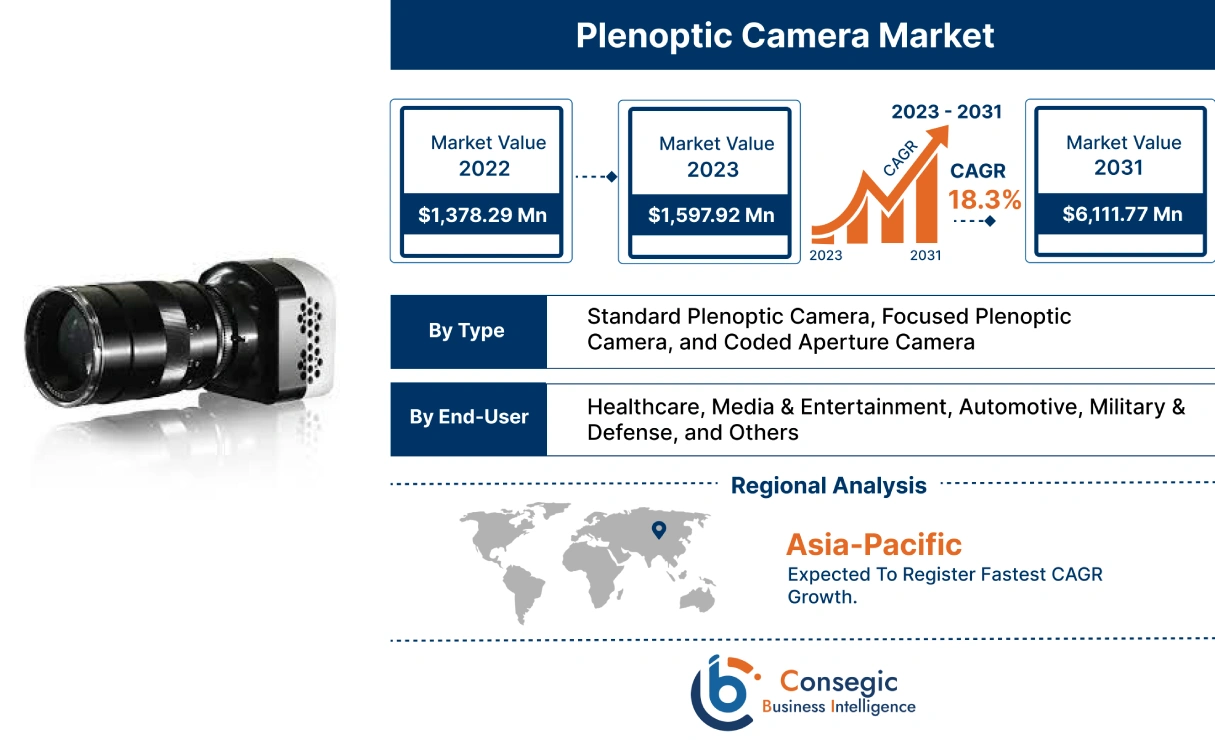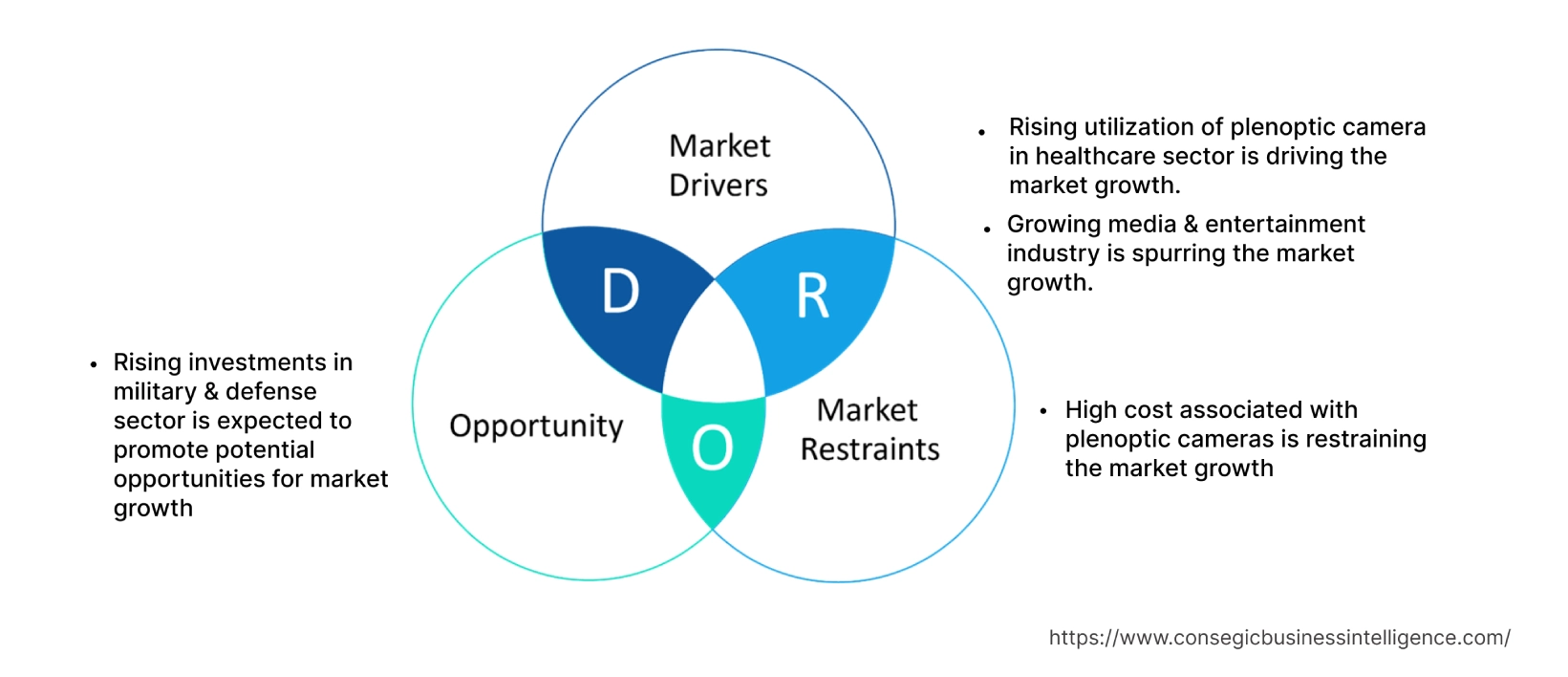- Summary
- Table Of Content
- Methodology
Plenoptic Camera Market Size :
Plenoptic Camera Market size is estimated to reach over USD 6,111.77 Million by 2031 from a value of USD 1,378.29 Million in 2022 and is projected to grow by USD 1,597.92 Million in 2023, growing at a CAGR of 18.3% from 2023 to 2031.
Plenoptic Camera Market Scope & Overview:
Plenoptic cameras, also known as light field cameras, are designed for capturing information about the light field or intensity of light originating from a scene along with the precise direction in which the light rays are traveling in space. The above characteristics of plenoptic cameras enable new imaging capabilities including refocusing the attained image to various depths and viewing the same scene from different perspectives. Moreover, plenoptic cameras offer several benefits including greater detail and higher resolution images as compared to traditional cameras. The aforementioned benefits of plenoptic cameras are key determinants for increasing the utilization in healthcare, media & entertainment, automotive, military & defense, and other sectors.
Plenoptic Camera Market Insights :
Key Drivers :
Rising utilization of plenoptic camera in healthcare sector is driving the market growth
Plenoptic cameras are primarily used in the healthcare sector, particularly in medical or surgical procedures conducted in healthcare facilities. Moreover, plenoptic cameras are utilized in healthcare facilities during minimal invasive surgeries, attributed to its ability to offer high-resolution enhanced visual clarity during changing surgical scenes. Additionally, plenoptic cameras are also used in applications including scientific imaging, cancer research, endoscopy, and others.
Factors including the rising healthcare expenditure, expansion of healthcare facilities, and increasing number of surgical procedures are among the key aspects driving the adoption of plenoptic cameras.
For instance, according to the Organization for Economic Co-operation and Development (OECD), the total number of cataract surgical procedures in Germany reached 945,726 surgeries, depicting an increase 10.2% as compared to 858,553 surgeries in 2020. Additionally, the UPMC Hillman Cancer Centre located in Sicily, Italy commenced operations in from May 2022. The recently completed healthcare facility enables the healthcare professionals to provide medical oncology services that supplement the hospital's surgical capabilities, along with a specific focus on cardiothoracic and gastrointestinal and cancers. Therefore, the rising expansion of healthcare facilities and increasing number of surgical procedures is increasing the utilization of plenoptic cameras during surgical procedures conducted in healthcare facilities, in turn driving the growth of the market.
Growing media & entertainment industry is spurring the market growth
Plenoptic cameras are used in the media & entertainment industry for applications involving cinematography. Moreover, the ability of plenoptic cameras to capture information associated with the manner in which the light is being reflected off objects in the scene enables partial reconstruction of 3D space in front of the camera, in turn augmenting virtual reality. The above features of plenoptic cameras are key determinants for increasing the utilization in the media & entertainment industry.
Factors including the rising investments in the media and entertainment sector, growing consumer shift towards digital content for entertainment activities, and increasing penetration of social media for content distribution are among the major factors driving the growth of the media & entertainment industry.
According to the Motion Picture Association, the global entertainment industry was valued at USD 78.5 billion in 2021, representing a growth of 14% as compared to 2020 and 41% in comparison to 2019. Additionally, according to India Brand Equity Foundation, foreign direct investment in the media and broadcasting sector in India was valued at USD 9.85 billion as of September 2022.
Therefore, the growing media and entertainment industry is increasing the adoption of plenoptic cameras for application in cinematography, in turn proliferating the market growth.
Key Restraints :
High cost associated with plenoptic cameras is restraining the market growth
The deployment of plenoptic cameras is often associated with high cost, which is a key factor constraining the market growth. For instance, Raytrix GmbH, a European manufacturer of plenoptic cameras, offers a range of R5 high-speed light field cameras (plenoptic cameras) with prices ranging from USD 10,836 to USD 21,683 per unit, depending on the specifications of the camera, which is relatively very high.
Therefore, the high cost associated with the utilization of plenoptic cameras is restraining the growth of the market.
Future Opportunities :
Rising investments in military & defense sector is expected to promote potential opportunities for market growth
The rising investments in the military & defense sector is expected to present potential opportunities for the growth of the plenoptic camera market. Plenoptic cameras are deployed in the military & defense sector, particularly for various applications including surveillance, patrolling, security, and others. Moreover, plenoptic cameras enable focus reconstruction, in turn increasing the depth of field. The above feature of plenoptic camera makes it ideal for deployment in military & defense sector for surveillance applications.
Factors including the growing investments in military & defense vehicles and equipment along with increasing production of air defense systems are expected to promote significant growth prospects for the market.
For instance, in May 2021, the Italian Government invested USD 15 billion in the aerospace and defense industries with the aim of strengthening the country's national aerospace, defense, and security industrial chain. Additionally, in March 2021, the U.S. Government allocated around USD 752.9 billion budget for national defence for FY 2022, among which USD 715 billion was allotted for the Department of Defence of the United States. The FY 2022 Defence Budget submission aims at enhancing capabilities of the U.S. military and national security.
Therefore, rising investments in the military & defense sector is projected to increase the adoption of plenoptic cameras for multiple applications including surveillance, patrolling, security, and others, in turn facilitating opportunities for market growth during the forecast period.
Plenoptic Camera Market Report Insights :
| Report Attributes | Report Details |
| Study Timeline | 2017-2031 |
| Market Size in 2031 | USD 6,111.77 Million |
| CAGR (2023-2031) | 18.3% |
| By Type | Standard Plenoptic Camera, Focused Plenoptic Camera, and Coded Aperture Camera |
| By End-User | Healthcare, Media & Entertainment, Automotive, Military & Defense, and Others |
| By Region | North America, Europe, Asia-Pacific, Latin America, and Middle East & Africa |
| Key Players | Raytrix GmbH, Digital Optical Imaging Technologies S.L., VOMMA (Shanghai) Technology Co., Ltd., Avegant Corp., Holografika, Ricoh |
| Geographies Covered | |
| North America | U.S. Canada Mexico |
| Europe | U.K. Germany France Spain Italy Russia Benelux Rest of Europe |
| APAC | China South Korea Japan India Australia ASEAN Rest of Asia-Pacific |
| Middle East and Africa | GCC Turkey South Africa Rest of MEA |
| LATAM | Brazil Argentina Chile Rest of LATAM |
| Report Coverage | Revenue Forecast, Competitive Landscape, Growth Factors, Restraint or Challenges, Opportunities, Environment & Regulatory Landscape, PESTLE Analysis, PORTER Analysis, Key Technology Landscape, Value Chain Analysis, Cost Analysis, and Regional Trends & Forecast |
Plenoptic Camera Market Segmental Analysis :
By Type :
Based on the type, the market is bifurcated into standard plenoptic camera, focused plenoptic camera, and coded aperture camera. The standard plenoptic camera segment accounted for the largest revenue share of 51.03% in the year 2022. Standard plenoptic cameras enable quick computation of a refocused image, depth of field, and refocused object distance by utilizing extracted multi-view images. Moreover, standard plenoptic cameras are often used for visualizing both conventional and unconventional molecular assemblies including RNA, DNA, viruses, protein, other complex molecules, making it ideal for utilization in healthcare sector for research and laboratory applications.
For instance, according to American Medical Association, the overall healthcare expenditure in the U.S. was valued at USD 4.3 trillion in 2021, representing an incline of 2.7% as compared to 2020. Thus, rising investment in healthcare sector is among the key factors driving the adoption of plenoptic cameras for utilization in healthcare research and laboratory applications, in turn contributing to the growth of the market.
The focused plenoptic camera segment is anticipated to register fastest CAGR growth during the forecast period. Focused plenoptic camera utilizes an array of micro lenses for focusing light onto the sensor, which enables the sensor to capture more light than conventional cameras, in turn resulting in higher image quality. Moreover, focused plenoptic cameras offer several benefits including capturing of images with a much higher dynamic range and generation of shallow depth of field, which enables the creation of blurring background effects. The above benefits of focused plenoptic cameras make it ideal for utilization in media & entertainment, and other industries.
For instance, according to the Motion Picture Association, the entertainment industry in the United States was valued at USD 32.3 billion in 2021, depicting a growth of 7% in comparison to 2020. Focused plenoptic cameras are used in the entertainment industry for applications involving cinematography. Therefore, the growth of the media & entertainment industry is a primary factor anticipated to drive the market growth during the forecast period.
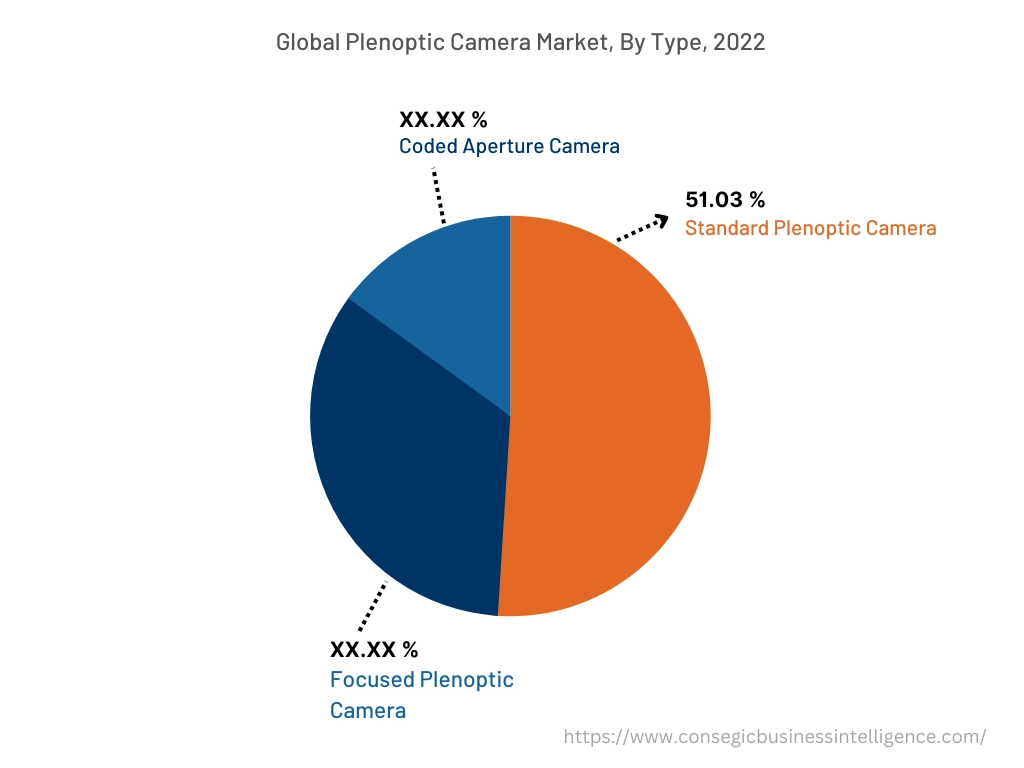
By End-User :
Based on the end-user, the market is segregated into healthcare, media & entertainment, automotive, military & defense, and others. The healthcare segment accounted for the largest revenue share in the year 2022. Factors including the rising healthcare expenditure, expansion of healthcare facilities, and increasing number of surgical procedures are driving the growth of the healthcare segment.
For instance, Raytrix GmbH offers a range of 3D light field cameras with 4D plenoptic RGB-depth express sensors others in its product portfolio that are designed for healthcare applications. Thus, the rising development of plenoptic cameras for utilization in healthcare applications is driving the growth of the market.
Media & entertainment segment is expected to witness fastest CAGR growth during the forecast period. The growth of media & entertainment segment is attributed to several factors including growing consumer shift towards digital content for entertainment activities, increasing demand for VOD (video-on-demand) content, and rising investments in media and entertainment sector among others.
For instance, according to European Audio-Visual Observatory, VOD (video-on-demand) sector was valued at USD 13.2 billion in 2020, and its growth was mainly driven by the rapid shift in consumer preference towards content that is accessible at any time, any place, and any device. Thus, the growth of media & entertainment sector is projected to drive the adoption of plenoptic cameras for application in cinematography, in turn proliferating the market growth during the forecast period.
By Region :
The regional segment includes North America, Europe, Asia Pacific, Middle East and Africa, and Latin America.
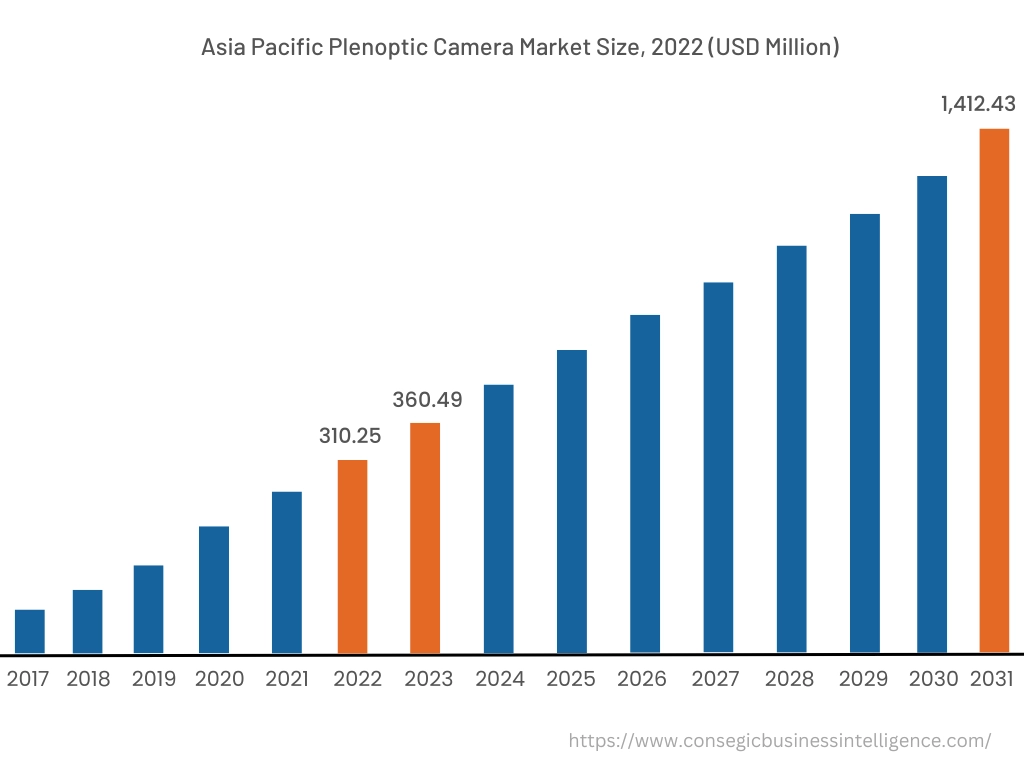
Europe is estimated to reach over USD 2,365.26 Million by 2031 from a value of USD 526.51 Million in 2022 and is projected to grow by USD 611.07 Million in 2023. The adoption of plenoptic cameras in the European region is mostly driven by the utilization in healthcare, media & entertainment, military & defense, and other sectors. Moreover, the growing healthcare industry and increasing utilization of plenoptic cameras in healthcare facilities for application in minimally invasive surgeries, cancer research, endoscopy, and others are among the significant factors driving the market growth in the region.
For instance, according to the European Commission, the total government healthcare expenditure in the EU reached up to USD 202.7 billion in 2021, accounting for 8.1% of the total GDP. Additionally, the European Commission invested approximately USD 6 billion budget for 2021-27 period with the aim of supporting the healthcare sector in Europe. Thus, the growth of healthcare industry is boosting the deployment of plenoptic cameras, in turn accelerating market growth in the European region. Additionally, increasing investments in expansion of military & defense sector is anticipated to promote lucrative growth aspects for the market in Europe during the forecast period.
Asia-Pacific is expected to register fastest CAGR growth of 18.6% and is estimated to reach over USD 1,412.43 Million by 2031 from a value of USD 310.25 Million in 2022 and is projected to grow by USD 360.49 Million in 2023. In addition, in the region, the China accounted for the maximum revenue share of 28.9% in the same year.
The growing pace of industrialization and development is creating lucrative growth aspects for the market in the region. Additionally, factors including the growth of various industries including media & entertainment, military & defense, and others are driving the market growth for plenoptic camera in the Asia-Pacific region.
For instance, according to Invest India, the Government of India allocated USD 70.6 billion to the Ministry of Defense as the part of its Union Budget 2022-23. The investment aims at developing new military ground vehicles, unmanned vehicles and systems, and other related defense systems. Plenoptic cameras are used in the military & defense sector, primarily for applications including surveillance, patrolling, security, and others. Therefore, rising investments in the military & defense sector in the Asia-Pacific region is anticipated to drive the utilization of plenoptic cameras, thereby, proliferating market growth in the region during the forecast period.
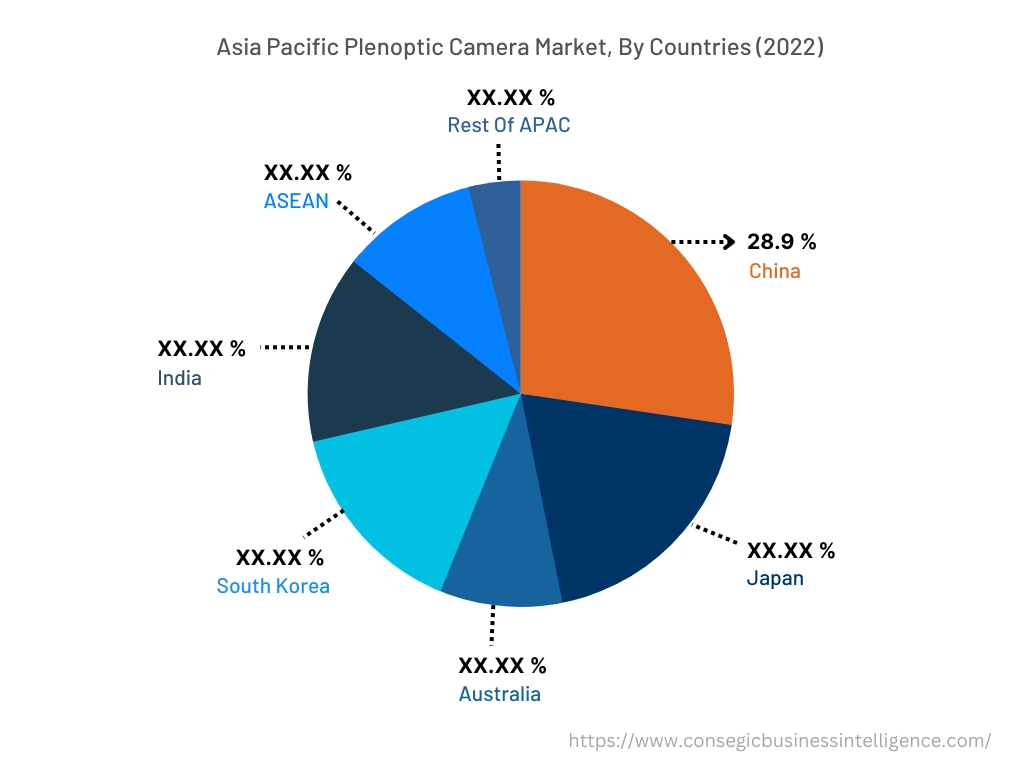
Top Key Players & Market Share Insights:
The plenoptic camera market is highly competitive with major players providing plenoptic camera to the national and international markets. Key players are adopting several strategies in research and development (R&D), product innovation, and end-user launches to hold a strong position in plenoptic camera market. Key players in the plenoptic camera market include-
- VOMMA (Shanghai) Technology Co. Ltd.
- Avegant Corp.
- Holografika
Key Questions Answered in the Report
What is plenoptic camera? +
Plenoptic cameras, also known as light field cameras, are designed for capturing information about the light field or intensity of light originating from a scene along with the precise direction in which the light rays are traveling in space.
What specific segmentation details are covered in the plenoptic camera report, and how is the dominating segment impacting the market growth? +
For instance, by type segment has witnessed standard plenoptic camera as the dominating segment in the year 2022, owing to its increasing utilization in healthcare sectors among others.
What specific segmentation details are covered in the plenoptic camera market report, and how is the fastest segment anticipated to impact the market growth? +
For instance, by end-user segment has witnessed media & entertainment as the fastest-growing segment during the forecast period due to rising adoption of plenoptic camera in media & entertainment sector for application involving cinematography.
Which region/country is anticipated to witness the highest CAGR during the forecast period, 2023-2031? +
Asia-Pacific is anticipated to register fastest CAGR growth during the forecast period due to rapid pace of industrialization and growth of multiple industries such as media & entertainment, military & defence, and others.
